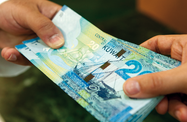The outlook for Kuwait’s banking system over the next 12-18 months remains stable, according to a recent report by Moody’s Investors Services. Asset quality has improved markedly since the days of the global financial crisis, and lenders are well capitalised. However, the country’s lenders face other challenges, most notably a sluggish economy that has left demand for loans – particularly on the corporate side – limited.
In early April, the ratings agency reported that it expected the banking sector’s overall asset quality to remain at a level similar to that of late 2011, when the rate of non-performing loans stood at around 6%. Moody’s noted that there are some downside risks to asset quality over the projection period, in part due to single-party exposures, but with strong capitalisation levels, the banks have room to absorb any substantial loan losses.
Indeed, according to Randa Azar, the group head of strategy and research at the National Bank of Kuwait (NBK), the country’s largest bank, lenders in Kuwait and the larger region are well capitalised. “The starting point for many banks in the Gulf is pretty strong right now; capital adequacy and liquidity is not really a problem in the region,” she told FTSE Global Markets magazine in April, adding that “a good number of banks are already compliant with both Basel II and Basel III, at least on the capital ratio side”.
This view was echoed by Moody’s, which pointed out that the banking system’s liquidity remains at a comfortable level, bolstered by deposits from cash-rich, government-related businesses that are doing well in an era of high oil prices. Lenders also have access to government and quasi-government deposits, which have remained relatively constant, even during tough economic times.
While analysts seem to agree that funding is not an issue, there is a greater degree of uncertainty when it comes to the question of whether or not there will be demand for the capital currently sitting in the country’s banks. According to Moody’s, high oil earnings are likely to boost government spending and provide stimulus to the non-oil private sector economy, thus creating greater demand for banking services. The ratings agency also noted that credit negative factors include “discord between the executive and legislative (parliament) branches of the government that continue to cause delays in the implementation of economic policy”.
Indeed, Ibrahim Dabdoub, the CEO of NBK, in an April 16 interview with the Gulf Times, made a similar point. “The business environment is still slow here, mainly because government expenditure is still slow,” he said.
For first quarter of 2012, NBK reported profits of KD81m ($290.76m), compared to KD80.7m ($289.68m) for the same period in 2011. “We would have loved to have better growth, but there is no demand for loans at all. There is demand on the consumer side, but not on the corporate side,” Dabdoub said.
One factor that could stimulate demand for bank credit, at least in Kuwait, would be the implementation of the National Development Plan (NDP), a four-year economic programme that was approved by the Kuwaiti parliament in February 2010. The NDP calls for several hundred projects and initiatives in areas such as housing, health care and transport, with total spending projected to reach an estimated $108bn and about half of this to be financed by banks. However, the implementation of the development programme has been slower than expected.
Still, there are some bright spots in the sector. For example, Gulf Bank, the third largest in Kuwait, has continued its turnaround since the central bank stepped in to assist it in 2008, posting full-year net profits of KD30.6m ($109.84m) in 2011, up from KD19.06m ($70.36m) in 2010.
In an interview with FTSE Global Markets, Michael Accad, the CEO of Gulf Bank, attributed its success to new leadership at the bank. “We brought in an entire newly management team in the second half of 2009 to help us rebuild trust and profitability. We had to take huge reserves and provisions,” he said.
Indeed, Gulf Bank was not alone in increasing provisions in the wake of the financial crisis, but as banks have worked through their loan books, provisions are likely to come down, Moody’s noted in its April report, which will improve profitability. However, the ratings agency has projected that return on equity (ROE) and return on assets (ROA) will remain below the levels achieved during the surging growth years of 2006 and 2007, when ROE and ROA averaged 20-24% and 2.7-2.9%, respectively.
Despite high levels of liquidity, banks in the GCC continue to take a cautious stance, particularly in Kuwait, where lenders with credit exposure to the real estate sector and investment companies took a hit during the global economic crisis. If the government hastens the pace of its implementation of the NDP, however, a number of profitable opportunities for the nation’s banks could arise.

